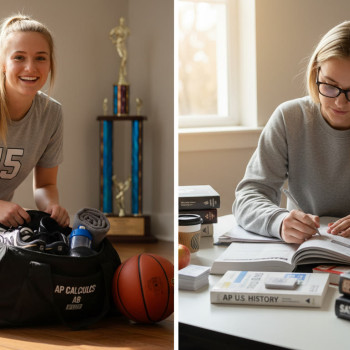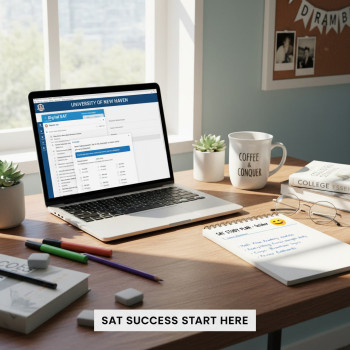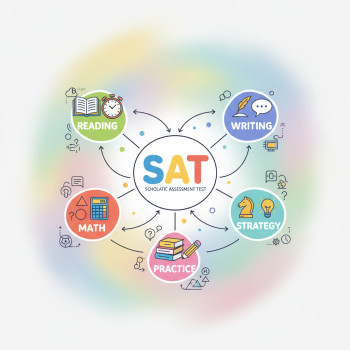Introduction: Balancing Varsity and Verbal — Why SAT Scores Still Matter for Athletes
If your life is a rhythm of practice, meets, games and study halls, the college application process can feel like another season to train for. As a student-athlete, your athletic achievements are a headline: they open doors to conversations with coaches, showcase your discipline, and can even attract recruiting attention. But admissions officers and coaches alike still look for academic evidence — and SAT scores are one of the clearest ways to show readiness for college-level work.
This post is for student-athletes and their parents who want a realistic, hopeful, and tactical view of how SAT scores fit into admissions and recruiting. We’ll walk through how coaches use scores, when to take the digital SAT, how to present scores alongside athletic accomplishments, and practical study approaches — including how Sparkl’s personalized tutoring can help keep both your GPA and test prep in peak condition.

How Colleges and Coaches Actually Use SAT Scores
Different people in the admissions process have different priorities. Understanding these perspectives helps you decide where to focus your energy.
Admissions Offices
Admissions teams evaluate applicants holistically: grades, coursework rigor, essays, recommendations, activities, and — when submitted or required — standardized test scores. For student-athletes, a solid SAT score can:
- Confirm academic readiness for core coursework.
- Serve as a tie-breaker among otherwise similar applicants.
- Qualify students for scholarships, honors programs, or merit aid where scores are considered.
Coaches and Athletic Departments
Coaches focus first on athletic talent and how a player fits their program. But they also care that recruits can academically qualify, become eligible with the NCAA (or other governing body), and stay eligible once they arrive on campus. SAT scores can play several roles for coaches:
- Eligibility screening: coaches will confirm the recruit meets the academic entry and NCAA requirements (transcripts, core-course completion, and test scores where applicable).
- Recruiting filters: while raw athleticism is key, coaches sometimes use academic indicators, including test scores, to assess a recruit’s likelihood of handling a college workload.
- Scholarship decisions: some athletic scholarships are fully merit-based or use academics as part of the award calculation.
Test-Optional Policies and the Reality for Athletes
In recent years many colleges adopted test-optional policies. That doesn’t mean scores are irrelevant — it means you get to choose whether your SAT strengthens your story. For athletes, the choice should be strategic:
- If your SAT score complements a strong GPA and rigorous schedule, include it.
- If your score is lower than your transcript suggests you can do, consider leaving it out — but discuss this with your guidance counselor and coach.
- For scholarship consideration and certain programs, submitting a score can still matter even when admissions are test-optional.
Timing the Digital SAT: When to Test Around the Season
Timing is tactical. The digital SAT’s cadence, your training schedule, and the recruiting calendar all influence when to sit for the test.
When to Take the SAT as a Freshman or Sophomore
Early exposure to the test format is valuable. Taking a practice digital SAT or an official PSAT-style exam in sophomore year helps you:
- Understand pacing and adaptive digital features.
- Identify weak areas to target over the next year.
- Build confidence without the pressure of submitting scores.
Junior Year: The Key Testing Window
Junior year is prime time. Aim to be testing by the spring so you have time for a retake if needed. Why spring?
- Many athletes have lighter fall seasons academically focused on recruitment; spring allows focused study blocks.
- Scores from spring tests are available for early college application planning.
Senior Year: Retakes and Late Decisions
A senior-year retake can make sense if scores from junior year don’t reflect your growth. But weigh it against college application deadlines, visits, and the intensity of fall competition. If you’re juggling a busy season, plan a retake during a lull or after commitment decisions are due.
Practical Strategies: Study Plans That Fit Training Schedules
Study smart, not just hard. The best plan respects your training, travel, and recovery time while giving focused practice for the SAT’s unique demands.
Micro-Sessions and Consistent Practice
Short, consistent sessions beat last-minute marathons. Try 25–40 minute study blocks that fit between practice and homework. Use those sessions for:
- Focused content practice (e.g., algebra, evidence-based reading passages).
- Timed sections to build digital pacing and stamina.
- Reviewing errors and tracking recurring question types.
Simulate Test Conditions
Once every 2–4 weeks, take a full, timed digital practice test. Simulate your test-day routine — breakfast, travel time, and timing between sections. This helps build mental resilience so you’re not surprised on test day.
When to Use Tutoring — and How Personalized Help Pays Off
Tutoring is most effective when it’s tailored. A one-size-fits-all tutor won’t optimize the same way a coach tailoring plays to your position would. Look for:
- Diagnostic-driven plans that focus on your specific weaknesses.
- 1-on-1 pacing strategies tied to the digital format.
- Feedback loops that track performance improvements across sections.
Sparkl’s personalized tutoring is worth considering: their 1-on-1 guidance, tailored study plans, and expert tutors help you balance athletic schedules with focused SAT prep. They also use AI-driven insights to track improvement trends and prioritize the most impactful study areas — a useful edge for busy student-athletes.
Test Day Tips for Athletes: Treat the SAT Like a Big Meet
Adopt the rituals that work before a game: warm-up, routine, and recovery. On test day:
- Get a full night’s sleep and eat a balanced breakfast — protein and complex carbs to sustain focus.
- Bring everything you need for the digital SAT based on the College Board’s current checklist (admission ticket, approved ID, permitted devices/tools if applicable, and any SSD accommodation documentation).
- Warm-up with a 10–15 minute light review of formulas or quick reading passages — nothing intense that raises stress levels.
- Use pacing and break strategies you practiced during simulations. The digital SAT gives built-in tools; know how to use them beforehand.

Eligibility and Accommodations: What to Know for NCAA and Accessibility
Academic eligibility for athletics often involves transcripts, GPA, required coursework, and sometimes test scores for NCAA or other governing bodies. If you require accommodations, the digital SAT has updated processes and tools.
Accommodations on the Digital SAT
The College Board has detailed rules for Services for Students with Disabilities (SSD). Key points to plan for:
- Apply early — getting approved can take weeks, and some accommodations (like screen readers) are provided differently on digital tests.
- Practice with the approved accommodations in the official Bluebook app or practice platforms to avoid surprises.
- If you have existing school-approved accommodations, coordinate with your counselor and the College Board SSD office to ensure continuity for the SAT.
How to Present SAT Scores in a Recruiting Packet and Application
Your recruiting packet is your highlight reel plus academic credibility. How you present test scores matters.
Recruiting Email or Profile Tips
- Include your SAT score near GPA and class rank in a quick stats block so coaches can see academics at a glance.
- If you have a standout section score (e.g., math), mention it to reinforce academic strengths related to your major interests (engineering, business, etc.).
- If you’re test-optional and your score strengthens your application, attach it with a short note explaining how it complements your academic record.
Application Essays and Context
Your essays and counselor recommendation can explain training demands, travel schedules, and how athletics shaped your academic habits. If your SAT score is lower than expected, use these documents to show upward trends in grades or to explain extenuating circumstances — not excuses, but context.
Sample Comparison Table: Where SAT Scores Matter Most for Athletes
| Situation | Are SAT Scores Important? | Why | Recommended Action |
|---|---|---|---|
| Top-tier Division I schools (competitive programs) | Often yes | Academic readiness and scholarship considerations; admissions standards can be high | Take SAT early; aim for competitive score; use targeted tutoring |
| Test-optional selective colleges | Case-by-case | Scores can strengthen a strong athletic application, but not required | Submit scores only if they add to your narrative |
| Scholarship evaluations | Yes | Many merit awards consider standardized scores | Submit your best score; explore scholarship-specific requirements |
| Community colleges or two-year programs | Usually less important | Admissions often emphasize GPA and placement tests | Focus on grades and transfer pathway planning |
Real-World Examples and Scenarios
Here are a few realistic scenarios and recommended approaches:
Scenario 1 — The Nationally Ranked Swimmer with Limited Test Time
Problem: Travel meets make focused study difficult. GPA is strong but SAT practice shows inconsistent scores.
Approach: Schedule micro-study blocks during travel and recovery days. Use Sparkl’s 1-on-1 tutoring to create a tailored plan that targets weaknesses with flexible session times. Aim for one full practice test between seasons and a retake in an off-season week.
Scenario 2 — The Soccer Player Applying Test-Optional to Top Schools
Problem: Tests are optional, but the athlete wants to stand out academically for scholarship consideration.
Approach: If practice tests show a score that complements GPA, submit it. Otherwise, bolster the application with a strong personal statement and teacher recommendations that highlight time management and leadership from athletics.
Scenario 3 — The Student with Learning Accommodations
Problem: Approved accommodations in school don’t always map 1:1 to the digital SAT format.
Approach: Start the accommodation request early with the College Board’s SSD office, practice within the Bluebook app with the approved tools, and plan test dates around the approval timeline. Communicate with coaches and counselors so they understand how accommodations were provided.
Scholarships, Financial Aid, and the SAT
Even when admissions are test-optional, many scholarships still consider standardized test scores. A strong SAT score can unlock merit aid packages that make a big difference — especially if you’re balancing recruitment offers with academic scholarships.
To maximize opportunities:
- Research scholarship criteria early; some require scores even if the school is test-optional for admission.
- Submit scores for scholarship applications where they strengthen your case.
- Coordinate with your school counselor to identify regional or sport-specific scholarships that prioritize academic metrics.
Mental Game and Recovery: Keeping Stress from Undermining Performance
Test anxiety is no different from pre-game nerves — both respond to routines, visualization, and controlled breathing. Build simple rituals:
- Pre-test breathing routine (4–4–4 breathing: inhale 4s, hold 4s, exhale 4s).
- Positive warm-up: a quick review of past successes (a good practice or a solved tough problem).
- Post-test recovery: plan something restful and rewarding — a recovery routine just like after a meet.
Mental resilience coaches, sports psychologists, and tutors who understand athletes’ schedules can help translate physical performance strategies into test-day calm.
Final Checklist: A Game Plan for Student-Athletes
- Create a testing timeline with your coach and counselor — include potential retake windows and recruitment milestones.
- Take at least one full-length digital practice test before officially registering.
- Use targeted tutoring focused on weak spots and realistic pacing; consider Sparkl’s tailored 1-on-1 sessions if you need flexibility and data-driven feedback.
- Decide whether to submit scores strategically based on each college’s policy and scholarship eligibility.
- Apply early for accommodations if needed and practice using them in the official digital interface.
- Balance test prep with rest and recovery — sleep, nutrition, and controlled practice beats last-minute cramming.
Closing Thought: Your Athletic Story and the SAT — Both Matter
As a student-athlete, you bring a rare blend of discipline, teamwork, and perseverance to your college applications. SAT scores are one tool in your broader narrative — not the only one. Use them strategically to support your academic case, and don’t be afraid to lean on expert help where necessary. A tailored approach — one that respects the demands of training, travel, and competition — will serve you best.
Whether you’re aiming for a Division I roster, a strong academic fit with athletic opportunities, or scholarships that make college affordable, plan early, practice smart, and keep your eye on the long game. Your performance on the field and in the test center are chapters of the same story: disciplined preparation, consistent execution, and thoughtful recovery.
Need help building a test plan that works with your season?
Coaches and counselors can help you map priorities, and personalized tutoring — such as Sparkl’s 1-on-1 guidance and tailored study plans — can fit study into your athletic life. If you want a study plan that moves at your pace, targets the high-return skills, and respects practice schedules, consider discussing a personalized tutoring option with your counselor or coach.
Good luck — on the field and at the test center. When you combine athletic grit with intentional academic preparation, you give yourself the best chance to choose where you’ll play and learn next.

















No Comments
Leave a comment Cancel